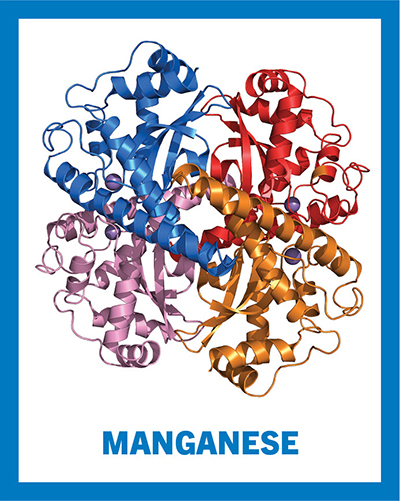Manganese seldom travels alone
We mark the 150th anniversary of Dimitri Mendeleev’s periodic table of chemical elements this year by highlighting elements with fundamental roles in biochemistry and molecular biology. So far, we’ve covered hydrogen, iron, sodium, potassium, chlorine, copper, calcium, phosphorus, carbon, nitrogen and oxygen.
 This ribbon diagram represents the structure of the human superoxide dismutase 2 tetramer in coordination with four manganese ions shown in violet.Fvasconcellos/Wikimedia Commons
This ribbon diagram represents the structure of the human superoxide dismutase 2 tetramer in coordination with four manganese ions shown in violet.Fvasconcellos/Wikimedia Commons
For September, we describe manganese, a transition metal with chemical symbol Mn and atomic number 25. Manganese is highly reactive, and it almost never is found as a free element in nature. Rather, it combines with other elements via its multiple oxidation states, which range from +7 to -3. It frequently is found in silicate, carbonate and oxide minerals, and in alloys — compounds containing metals — with iron. People used manganese-containing pigments that are naturally abundant in cave paintings dating back to the Stone Age.
Nuclear reactions that occur in giant stars immediately before supernova explosions produce manganese. It has a short half-life of about 3.7 million years and decays into one of the four chromium isotopes — element variants with different numbers of neutrons. At 0.1%, manganese is the 12th most abundant element on the Earth’s crust. A significant amount of manganese is present on the ocean floor in the form of manganese nodules — specific marine deposits composed by manganese hydroxide and iron.
In living systems, that combine with biological molecules in the aqueous environment of the cell. Mn+2 often overlaps and competes with magnesium and calcium ions as a structural component that stabilizes the net charge of molecules such as proteins and adenosine triphosphate. As a redox cofactor for a large variety of enzymes, manganese is at the catalytic center for cellular reactions that participate in aerobic metabolism.
Manganese is vital to microbial survival. Protein transporters in bacteria break down high-energy chemical bonds in adenosine triphosphate to drive the influx of manganese into the cell from the extracellular environment. Bacterial species of the normal flora of the human digestive and reproductive systems require manganese for survival and growth. The Lyme disease pathogen Borrelia burgdorferi can incorporate manganese in all of its metalloproteins, bypassing host defense by . The diphtheria toxin secreted by the pathogen Corynebacterium contains manganese in its structure. Some bacteria use nonenzymatic Mn+2 ion complexes — generally in combination with polyphosphate — to scavenge reactive oxygen species that are byproducts of cellular metabolic reactions.
In yeast and other eukaryotes, the natural resistance-associated macrophage protein, or NRAMP, uptake manganese using the driving force of proton gradients. Once inside cells, manganese serves as a cofactor for a multitude of enzymes that include oxidoreductases, carbohydrate-binding proteins such as lectins, and extracellular matrix receptors such as integrins.
Superoxide dismutase, an important manganese-containing enzyme present in mitochondria — and in most bacteria — partitions harmful reactive superoxide ions into molecular oxygen or hydrogen peroxide, protecting cells from the toxicity associated with aerobic respiration. In plants and cyanobacteria, manganese is an essential component of the enzyme responsible for the terminal oxidation of water during the light reactions of photosynthesis.
A year of (bio)chemical elements
Read the whole series:
For January, it’s atomic No. 1
For February, it’s iron — atomic No. 26
For March, it’s a renal three-fer: sodium, potassium and chlorine
For April, it’s copper — atomic No. 29
For May, it’s in your bones: calcium and phosphorus
For June and July, it’s atomic Nos. 6 and 7
Breathe deep — for August, it’s oxygen
Manganese seldom travels alone
For October, magnesium helps the leaves stay green
Enjoy reading ASBMB Today?
Become a member to receive the print edition four times a year and the digital edition weekly.
Learn moreGet the latest from ASBMB Today
Enter your email address, and weтАЩll send you a weekly email with recent articles, interviews and more.
Latest in Science
Science highlights or most popular articles

Guiding grocery carts to shape healthy habits
Robert тАЬNateтАЭ Helsley will receive the Walter A. Shaw Young Investigator in Lipid Research Award at the 2025 ASBMB Annual Meeting, April 12тАУ15 in Chicago.

Quantifying how proteins in microbe and host interact
тАЬTo develop better vaccines, we need new methods and a better understanding of the antibody responses that develop in immune individuals,тАЭ author Johan Malmström said.

Leading the charge for gender equity
Nicole Woitowich will receive the ASBMB Emerging Leadership Award at the 2025 ASBMB Annual meeting, April 12тАУ15 in Chicago.

CRISPR gene editing: Moving closer to home
With the first medical therapy approved, thereтАЩs a lot going on in the genome editing field, including the discovery of CRISPR-like DNA-snippers called Fanzors in an odd menagerie of eukaryotic critters.

Finding a missing piece for neurodegenerative disease research
Ursula Jakob and a team at the University of Michigan have found that the molecule polyphosphate could be what scientists call the тАЬmystery densityтАЭ inside fibrils associated with AlzheimerтАЩs, ParkinsonтАЩs and related conditions.

From the journals: JLR
Enzymes as a therapeutic target for liver disease. Role of AMPK in chronic liver disease Zebrafish as a model for retinal dysfunction. Read about the recent JLR papers on these topics.

